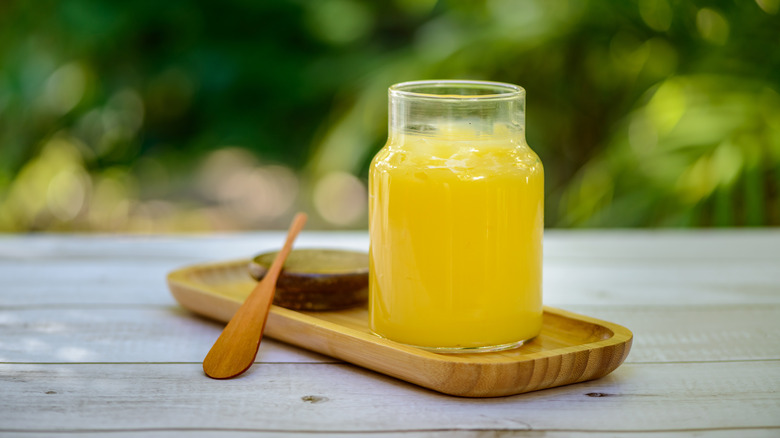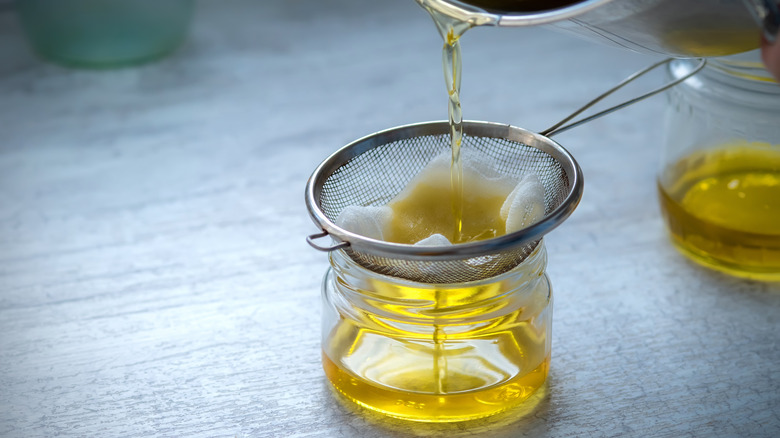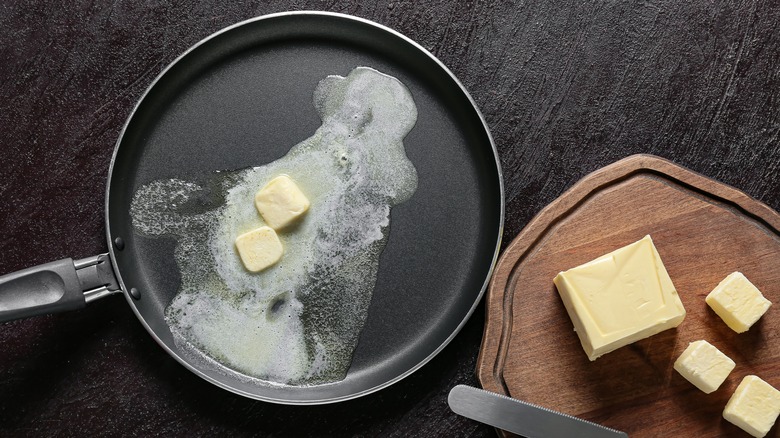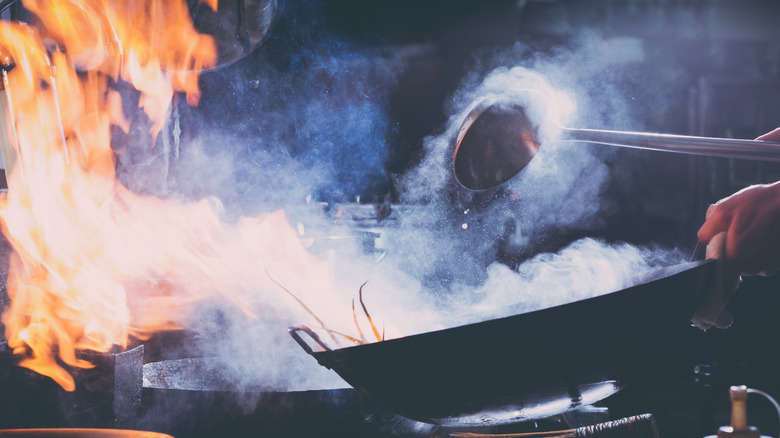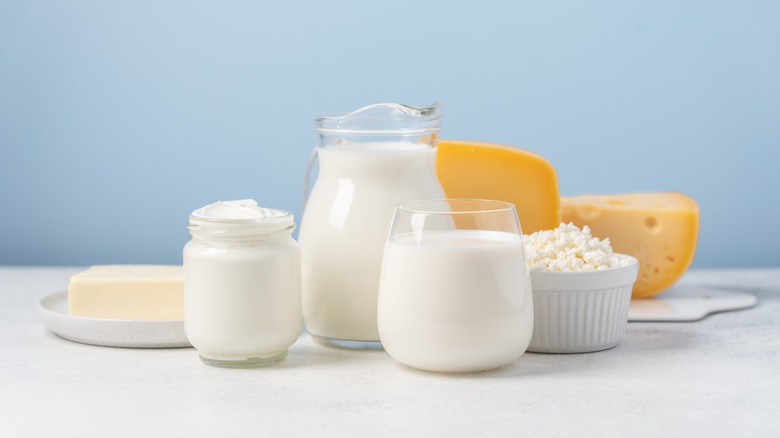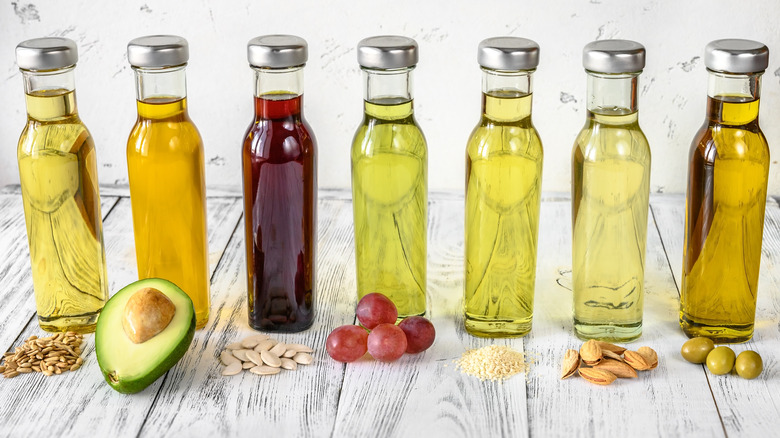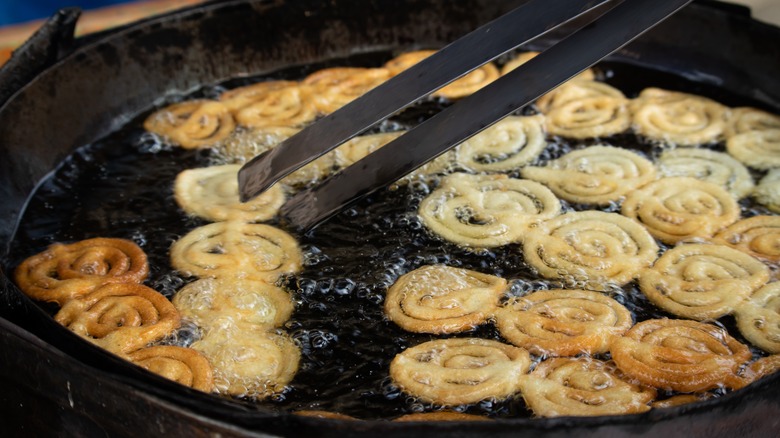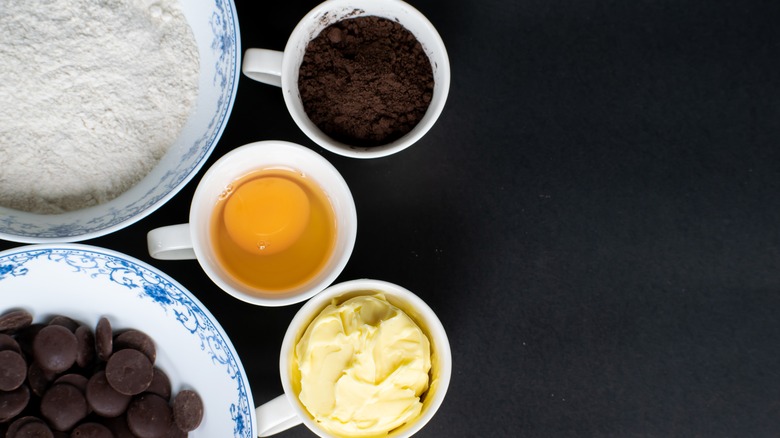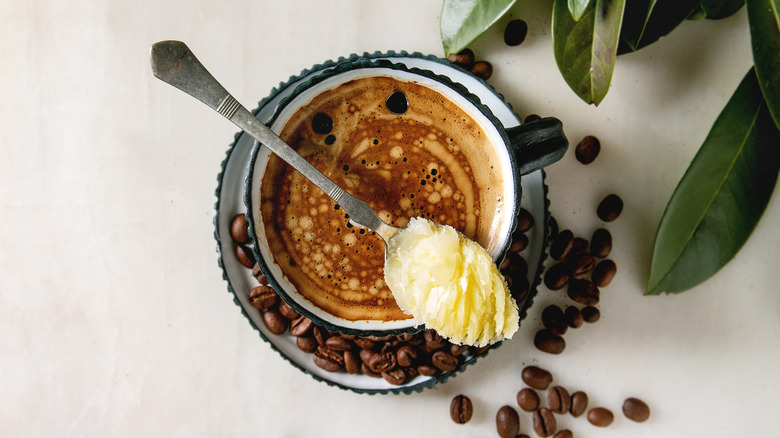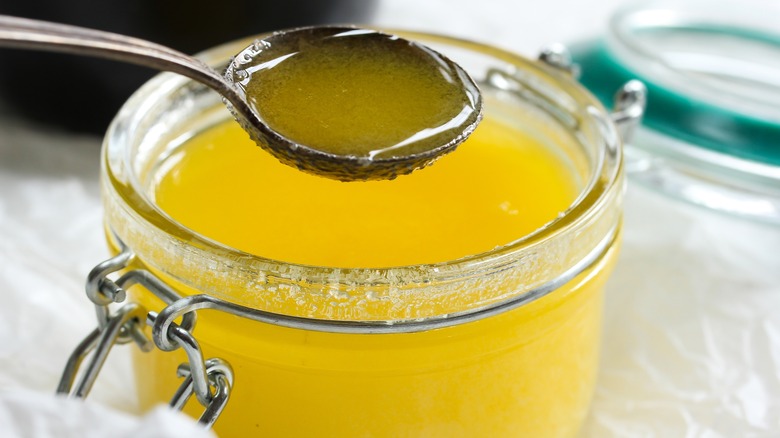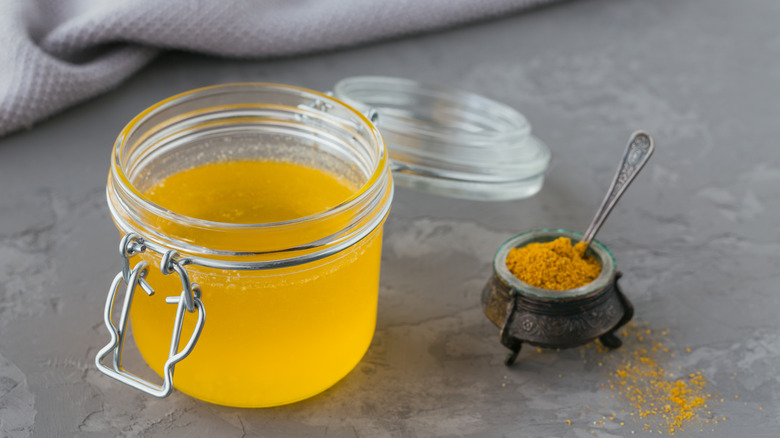12 Tips You Need When Cooking With Ghee
It's said that butter makes everything better, but we'd argue that there's another magical golden liquid that rivals butter in almost every way. Of course, it might not be fair to say that ghee trumps butter, considering that ghee can only be made by simmering butter until the water evaporates and the milk fats settle to the bottom of the pan. The result is almost nothing like its former self; a clear, shelf-stable cooking fat with a pronounced nutty flavor that's hard to resist.
Although ghee is having its time in the spotlight, it's not anywhere close to being new. According to Amita Nathwani, Ayurvedic practitioner and author of "My Mother's Ayurvedic Kitchen," ghee has been used in Ayurveda for thousands of years as both a medicine and as a cooking fat. Ghee has only recently found its way to popularity as a keto-friendly replacement for butter, or an addition to your morning cup of coffee.
While we feel strongly that ghee is fantastic in almost every application, there are a few considerations to take before you start cooking with ghee.
You can save money by making ghee at home
First things first: Before you head to the grocery store to pick up a jar of ghee for your favorite recipe, consider making it at home. Store-bought ghee can range in price, but it's often significantly more expensive than butter. Instead of paying the upcharge, you can transform that butter into ghee in about 30 minutes.
The process will sound familiar if you've made clarified butter, although you'll cook ghee a little longer. To make 2 cups of ghee, start by cutting a pound of unsalted butter into small cubes. Place it in a small sauce pot and bring it to a simmer over medium-high heat. When the butter begins to simmer and foam forms on the top, stir it and reduce the heat to medium-low. The foam will eventually evaporate as the butter becomes clear, allowing you to see the milk solids settling to the bottom.
You would stop here with clarified butter, but you'll keep going with ghee. Continue cooking over low heat for about 20 minutes, until the milk solids become light brown. Remove the pot from the stove and allow it to cool for 10 minutes. Strain the ghee through a cheesecloth-lined mesh strainer and store it in a pint jar.
Don't treat ghee the same as cooking with butter
Ghee and butter might be related, but the two are quite distinct. It's important to know how they differ before heating your frying pan. The main difference between butter and ghee is that ghee has been cooked to remove the milk solids. That process affects the flavor of the two fats: While butter tastes soft, creamy, and rich, ghee has a more concentrated flavor that's characterized by a deep nuttiness. The transformation also changes the smoke point (more on that in a moment).
While you can mostly use the two interchangeably, consider what you're cooking before you choose ghee over butter. If you're making a classic Indian recipe, ghee is the way to go. It will add a depth of flavor that you simply won't get with regular butter. On the other hand, if you're trying to make a recipe with browned butter, using ghee would be a mistake. These recipes rely on caramelizing butter's milk solids, something that just won't happen since they have already been removed from ghee.
Ghee is fantastic for recipes requiring high heat
We mentioned earlier that ghee has a different smoke point than butter. Every cooking oil or fat has a smoke point — the temperature where the fat begins to degrade and produce smoke. Using a fat with the wrong smoke point for your recipe can not only result in bitter, burnt flavors, but smoking oil also releases free radicals that may wreak havoc on the body by injuring cells and DNA (via The Health Sciences Academy).
Butter has one of the lowest smoke points of all cooking fats. It begins to smoke when it's heated to 302 F to 350 F, making it better for low-heat cooking like poaching or low-and-slow roasted meat and vegetables. Since ghee is pure fat and doesn't contain any milk solids, it doesn't start to smoke until it becomes much hotter. The Vegetarian Health Institute lists ghee as one of the highest smoke points at 485 F (15 F higher than canola oil, the fat with the next highest smoke point). That makes ghee fantastic for searing, stir-frying, grilling, or any other high-heat cooking method that triggers the Maillard reaction, a chemical reaction that gives food a desirable golden-brown crust when cooked at the right temperatures.
Ghee isn't 100% dairy free
In an interview with the Cleveland Clinic, registered dietitian Candace O'Neill reports that ghee is generally a good choice for those avoiding dairy. Butter already contains low levels of lactose and casein, but ghee has no lactose and only trace quantities of casein, an inflammatory milk protein (via Milkio). Therefore, O'Neill has found that people who have trouble digesting dairy seem to be able to tolerate ghee better than butter.
However, it's important to note that ghee is originally a dairy product — cow's milk that has been turned into butter — so it's not exactly 100% dairy free and certainly not vegan. Depending on your diet and preferences, that could mean ghee isn't right for you. Anyone with casein allergies should certainly steer clear. As far as those on a dairy-free diet (like the Paleo diet), there are conflicting sources of whether ghee is acceptable. The founder of the Paleo Diet, Loren Cordain, PhD., clears it up by saying ghee isn't recognized as an official addition to this dairy-free diet, advising followers to use olive oil or coconut oil instead.
Don't use ghee in recipes that call for neutral oil
While ghee is generally a good substitution for most cooking oils, we don't recommend using it in recipes that call for a neutral oil. There are over a dozen types of cooking oils, and some are more strongly flavored than others. For example, olive oil has a strong, almost peppery flavor, while palm oil has a savory, earthy character, and coconut oil is sweet and tastes of, well, coconut.
Then there are the so-called neutral oils, which don't taste like anything at all. Canola oil, vegetable oil, and sunflower oil are all great for cooking food without covering up the other seasonings in the dish. Using ghee as a substitution for these oils would be a mistake, as ghee has a distinctive nuttiness and it adds a subtle flavor to whatever it cooks. That's great when you're cooking curry, but ghee's aromatic makeup may not work as well in dishes with clear-cut flavor profiles, like salad vinaigrette or subtle soups like wonton soup.
Substitute ghee for butter or oil using a 1-to-1 ratio
Although you'll want to avoid ghee as a substitute for neutral oils, feel free to use it in any recipe where its nutty flavor makes sense. Swapping out the butter or cooking oil is a great way to incorporate more ghee into your diet for health or flavor reasons. It's as easy as using equal parts ghee for the fat called for in your favorite recipe.
Ghee's high smoke point makes it suitable for almost any cooking substitution. Australian chef Steve Hodges says he prefers cooking fish in ghee over oil because it crisps up the skin better without leaving behind an oily finish (via SBS). We also love using it instead of butter to make Martha Stewart's famous scrambled eggs, or choosing ghee over olive oil when roasting or sautéing vegetables. You can even deep fry in ghee: It's an obvious choice for an Indian dish like samosas, but it's fantastic for adding richness to deep-fried potato chips, battered shrimp, breaded chicken, or vegetable fritters.
Create Whole30 compliant desserts with ghee
Ghee is also fantastic for baking recipes, both for greasing cake pans and for mixing into the cake itself. The strong flavor and aroma make ghee an especially fantastic choice for sweet-and-savory recipes like salted cookies or brownies. Keep in mind that ghee won't work for all recipes, like those that require butter to hold its shape as it bakes. Croissants, for example, require a firm fat that takes a while to melt, and ghee's low melting point would ruin the rise (via Buttercream Bakeshop). Recipes like buttercream frosting wouldn't be a good choice for ghee, either, as the ghee would overpower the other delicate flavors in the dessert.
When it comes to dietary guidelines, it's often hard to keep up — especially when they keep changing! But those changes can sometimes benefit ghee lovers. The Whole30 diet is a short-term diet designed to give the body a reset by focusing on whole, unprocessed foods while avoiding inflammatory foods like dairy, grains, sugar, legumes, or alcohol. Since it contains dairy, butter is on the no-fly list. However, in 2011, Whole30 changed its program rules to make an exception for clarified butter or ghee. That's great news for anyone who likes to bake, because ghee can be used to make Whole30-compliant desserts.
Ghee doesn't need to be cooked
There are a ton of different ways to cook with ghee — but keep in mind that it doesn't need to be cooked at all. When we chatted with Ayurvedic practitioner Amita Nathwani about the traditional uses of ghee, most of them were not used in a cooking application. Raw ghee is featured prominently in Purva karma, an annual Ayurvedic cleanse that precedes the more well-known panchakarma. A spoonful of ghee is consumed daily before meals to remove toxins from the gut.
Nathwani explained that there are also plenty of non-cleanse reasons to consume uncooked ghee. It tastes great when spread on toast or used instead of butter in baked potatoes. It's Alton Brown's secret ingredient for perfect popcorn, too. He adds 3 tablespoons of ghee to popcorn kernels before popping them on the stovetop.
Ghee has also become popularized as an ingredient in bulletproof coffee. This type of coffee was originally made with MCT oil (coconut oil) and butter, although drinkers have found that ghee is a perfect substitute to add a distinct richness to the drink.
Store it at room temperature to keep it soft
Before you start cooking with ghee, you'll want to make sure you're storing it the right way. According to Does It Go Bad?, ghee is almost 100% fat, which means it can be safely stored at room temperature. You may be tempted to store ghee in the refrigerator, though, where it lasts three months longer after opening compared to room temperature. (In case you're wondering, it will last indefinitely when stored in the freezer.)
That said, ghee is difficult to use when it's stored in the refrigerator. Unlike hydrogenated fats like canola oil or vegetable oil, ghee and other saturated fats are still solid at room temperature (via LibreTexts Chemistry). In the refrigerator, ghee solidifies into a solid brick that's very hard to measure when cooking. If you store ghee or clarified butter in the pantry or on the counter, it will be semi-solid and much easier to scoop.
Of course, there's always an exception to the rule. For those who live in very warm environments, keep in mind that the increased temperature means that ghee will become fully liquid outside the fridge. You may want to consider storing ghee in the fridge and pulling it out an hour before cooking.
Ghee isn't right for everyone
Before your reach for that jar of ghee, keep in mind that ghee's health benefits may not be for everyone. Ayurvedic practitioner Amita Nathwani uses ghee in her practice, but it's not recommended for all patients. "We have to consider that everything can be a medicine and everything can be a poison, depending on who is ingesting it," she explains. "Ghee is pretty high in saturated fats, so it's great for brain health and vegetarians who need more saturated fat in their diet." She goes on to say that she wouldn't recommend ghee for her patients who are overweight, have a sluggish gallbladder, have high cholesterol, or anyone who tends to be more inflammatory in nature. "While the milk solids have been taken out, ghee can still invoke an inflammatory response in people sensitive to dairy."
For these patients, she recommends cooking with olive oil instead. A 2017 study comparing the effects of olive oil, butter, and coconut oil found supports this suggestion. The study found that all three fats increased total cholesterol levels, but the group that consumed olive oil saw the least increase. Only the group that consumed butter saw an increase in LDL cholesterol (the "bad" type).
It may increase the nutritional content of your meals
If you're looking for a reason to cook with more ghee, keep in mind that it may add more nutrients to your diet. According to VeryWell Fit, ghee contains vitamins A, E, and K, and cooking it with foods that have fat-soluble nutrients is a great way for your body to absorb additional vitamins and minerals. They also go on to say that ghee has less acrylamide than other cooking oils, reducing your exposure to potentially carcinogenic compounds.
Ghee is also rich in butyric acid. Gut bacteria naturally produce butyric acid, but supplementing with butyric acid-rich foods like ghee may help treat irritable bowel syndrome (IBS) and Crohn's disease, and may help reduce the risk of colon cancer (via Healthline).
Finally, grass-fed ghee contains high levels of conjugated linoleic acid (CLA), a polyunsaturated omega-6 fatty acid that has many potential nutritional benefits (via Healthline). One study showed that diets rich in CLA may reduce the risk of cardiovascular disease.
Consider combining ghee with other ingredients
Ghee is not only nutrient-dense on its own, but it's also possible to use it to increase the nutrient bioavailability of other foods. Amita Nathwani explains that bioavailability means the ability of a substance to be absorbed, allowing the body to use the nutrients. She says it's very common to infuse ghee with herbs and plants. The ghee itself is essential in this process because it contains no milk solids and it is "a very pure oil." When consumed, the medicated ghee can be absorbed into the bloodstream more quickly than herbs taken alone or with food.
You don't have to visit a practitioner to benefit from this aspect of ghee, either. Nathwani says all you need to do is cook ingredients like turmeric (or other fat-soluble ingredients that contain vitamins A, D, E, and K) in fat like ghee. This will increase their bioavailability and allow your body to better absorb curcumin, the component of turmeric that reduces inflammation.
If you have trouble digesting foods high in fat, Nathwani recommends cooking ghee with stimulating herbs like cumin and coriander. These spices will aid digestion by breaking down the saturated fats from ghee, helping the body absorb nutrients more easily.
